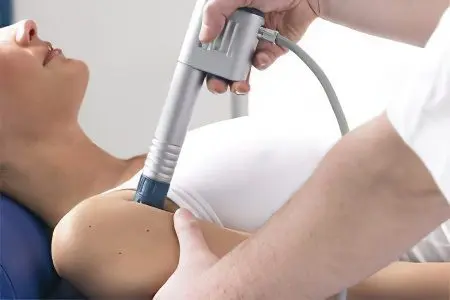Shoulder bursitis – This is an inflammatory process in the periarticular bag, which is accompanied by the accumulation of such a fluid, which is enriched not only with protein, but also with blood particles. This ailment should be attributed to diseases of the musculoskeletal system and is most common in those who play sports at a professional level and in people whose activities were associated with stress on the shoulder joints.
Shoulder bursitis symptoms

Symptoms of shoulder bursitis are as follows:
swelling in the joint area – at the initial stage it is not a problem, because the ability to move in the joint is not limited, and there are no painful sensations;
pain, palpable inflammation. This is especially acute when stretching or kneading during any training exercises;
limitation of motor volume, which is accompanied by sharp painful sensations, possibly the absence of pain;
redness of the skin and an increase in temperature exclusively over the joint area.
In protracted cases appears:
high temperature – up to 38 ° C;
purulent processes – with this scenario, manifestations begin to appear, indicating intoxication of the body – chills, migraines and an increase in temperature to 39-40 ° C. Without proper treatment, there is a possibility of developing a purulent type of arthritis;
pain becomes intense and throbbing.
Causes of shoulder bursitis
Bursitis of the shoulder joint can form as a result of tissue damage, for example, a strong blow or as a consequence of an infection. If damaged, it is aseptic bursitis, in case of infection, it is infectious.
Bursitis is formed after:
injury;
prolonged load on the shoulder joints;
wide swings of the arms in a certain amplitude.
Separately, it is necessary to talk about calcareous bursitis. This form of the disease is usually provoked by a violation of metabolic processes, and therefore treatment is a rather difficult task. With a similar form of the disease, the deposition of calcium salts is observed, which in certain situations provokes a deterioration in shoulder mobility.
Shoulder bursitis also forms in people over 50 years of age. At this age, the tone of these muscles becomes weaker. As a result, the shoulder joint, which was left without muscle protection, is much more exposed to traumatic injuries.
A cut or boil can cause the formation of bursitis, so no one is safe from the presented pathology. This is the so-called traumatic bursitis, which affects those who have not yet reached the age of 35, mainly men. And, despite the fact that such an ailment does not have critical consequences for human health in general, it must be borne in mind that repeated injuries to a damaged joint can become a catalyst for the formation of a permanent form of the disease. It is much more difficult to cure it.
Shoulder bursitis treatment

Regardless of the form of the disease, one of the first prescribed drugs that relieve inflammation, and at the same time non-steroidal type. Their goal is obvious – to relieve pain and significantly reduce inflammation. But such drugs cannot be used for a long period of time due to their side effects. Therefore, in the case of long-term treatment, NSAID dosages are either reduced or replaced with similar ones. In the primary form of the disease, they are used as gels and ointments.
Serous bursitis of the shoulder joint involves treatment with ointments and rest, but its purulent form needs a course of treatment with antibiotics, which are far from always sufficiently “strong”. In 30% of cases, there is a need for surgical intervention. In such a case, the bag is punctured, after which it is washed with a specific solution. In this case, we are talking about disinfectant solutions and cortecosteroids, after which the wound is cleaned until the inflammation disappears completely.
In the case of the development of a permanent form of the disease, surgical intervention is necessary in 80% of cases. In this case, we are not talking about a puncture, but about a bursectomy. This operation is an incision in the articular bag that has been damaged.
The methods of physiotherapy used in the treatment process most often only help to significantly reduce pain and swelling, and are completely ineffective with its purulent variety.
After getting rid of the exacerbation, it is possible to proceed to physiological procedures. Electrophoresis using calcium, iontophoresis with hydrocortisone, amplipulse, and magnetic treatment are actively used. As a result, the inflammation is finally removed, the edema becomes much less.
Improving the outflow of blood, strengthening the shoulder muscles and the girdle – all this can be achieved by introducing massage procedures into the treatment. Massage, like physiological procedures, is carried out after the exacerbation has been neutralized.
The effect achieved after massage and physiological procedures can be consolidated with the help of physiotherapy exercises (exercise therapy). Exercises begin to be done with minimal loads in terms of forcing and amplitude. In the future, depending on the form of bursitis and the neutralization of symptoms, it is desirable to expand the motor volume. At the same time, excessively intense and abrupt movements that cause pain are unacceptable.
An effect similar to exercise therapy and physiological procedures is achieved in the case of acupuncture. It is acupuncture of biologically active places that are located in certain anatomical areas.









